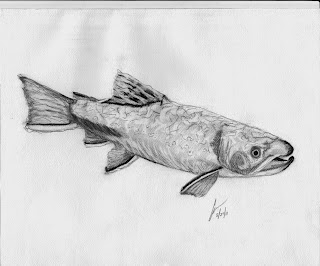 Fish, except large pelagic predatory species, for the most part, maintain a body temperature that are in relation to the water that they live in. They rely on an external heat source (ectotherms.) Ectotherms have lower metabolic rates and require less energy for basic activities, thus can survive on less food. These fish species experience environmental changes to temperatures seasonally and have cellular and subcellular mechanisms for adapting. These mechanisms are genetic. The effect of temperature on biochemical and physiological processes drives fish to select environments that allow for optimal functioning. These temperature preferences can be so strong, that a fish will not leave cooler waters to feed on prey that are located in warmer surface waters. These temperature preferences change as the fish grow. Waters that are suitable for juvenile fish are generally not adequate for adults, thus forcing the adults into deeper colder waters. This can cause decreased localized food sources, overcrowding and diseases.
Fish, except large pelagic predatory species, for the most part, maintain a body temperature that are in relation to the water that they live in. They rely on an external heat source (ectotherms.) Ectotherms have lower metabolic rates and require less energy for basic activities, thus can survive on less food. These fish species experience environmental changes to temperatures seasonally and have cellular and subcellular mechanisms for adapting. These mechanisms are genetic. The effect of temperature on biochemical and physiological processes drives fish to select environments that allow for optimal functioning. These temperature preferences can be so strong, that a fish will not leave cooler waters to feed on prey that are located in warmer surface waters. These temperature preferences change as the fish grow. Waters that are suitable for juvenile fish are generally not adequate for adults, thus forcing the adults into deeper colder waters. This can cause decreased localized food sources, overcrowding and diseases.
As the temperatures rise, there is increased evaporation and decreased water levels. This can lead to increased algal growth, and then increased bacterial action that leads to decreased oxygen levels in the colder parts of lakes making them inhabitable to Trout and other fish species. Lake Trout would be forced to move outside of their optimal temperature zone. The decreased water levels would mean that Brook Trout would loose access to portions of streams during summer months. This coupled with the already reduced habitat connectivity from undersized or perched culverts could have a significant impact on our native Brook Trout.
The above outcomes are not do to drastic temperature rises, but from as little as a couple degrees. Studies have already indicated that bodies of water within the Adirondacks have increased water temperatures and are showing increased algal growth and decreased oxygen levels.
To put it in perspective: Brook Trout function best at water temperatures at or below 65 degrees F. They can tolerate brief periods of between 24-48 hours at temperatures up to 72 degrees F. Even a few hours at 75 degrees F, Brook Trout will die. Lake Trout need waters that remain at or below 50 degrees F to survive.
No comments:
Post a Comment